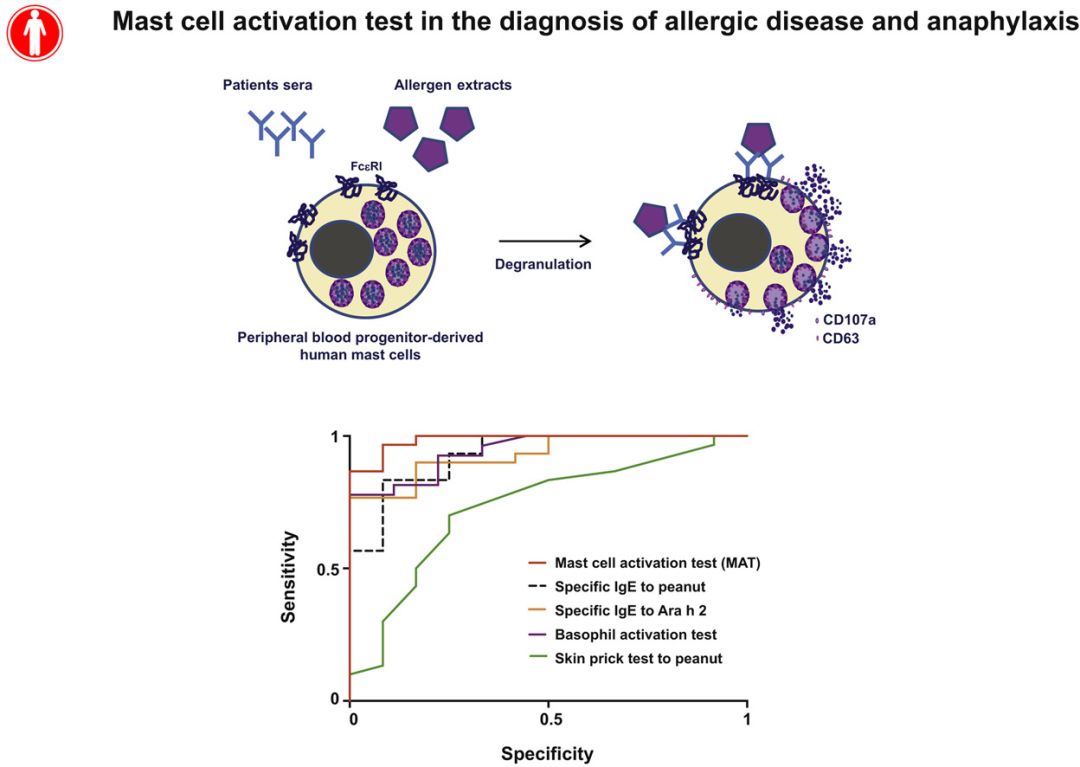JACI:肥大細(xì)胞活化試驗(yàn)在過敏診斷中的應(yīng)用
發(fā)布日期:2019-04-15
原標(biāo)題:肥大細(xì)胞活化試驗(yàn)在過敏性疾病和過敏反應(yīng)診斷中的應(yīng)用

延伸閱讀
DOI: https://doi.org/10.1016/j.jaci.2018.01.043
Background
Food allergy is an increasing public health issue and the most common cause of life-threatening anaphylactic reactions. Conventional allergy tests assess for the presence of allergen-specific IgE, significantly overestimating the rate of true clinical allergy and resulting in overdiagnosis and adverse effect on health-related quality of life.
Objective
To undertake initial validation and assessment of a novel diagnostic tool, we used the mast cell activation test (MAT).
Methods
Primary human blood-derived mast cells (MCs) were generated from peripheral blood precursors, sensitized with patients' sera, and then incubated with allergen. MC degranulation was assessed by means of flow cytometry and mediator release. We compared the diagnostic performance of MATs with that of existing diagnostic tools to assess in a cohort of peanut-sensitized subjects undergoing double-blind, placebo-controlled challenge.
Results
Human blood-derived MCs sensitized with sera from patients with peanut, grass pollen, and Hymenoptera (wasp venom) allergy demonstrated allergen-specific and dose-dependent degranulation, as determined based on both expression of surface activation markers (CD63 and CD107a) and functional assays (prostaglandin D2 and β-hexosaminidase release). In this cohort of peanut-sensitized subjects, the MAT was found to have superior discrimination performance compared with other testing modalities, including component-resolved diagnostics and basophil activation tests. Using functional principle component analysis, we identified 5 clusters or patterns of reactivity in the resulting dose-response curves, which at preliminary analysis corresponded to the reaction phenotypes seen at challenge.
Conclusion
The MAT is a robust tool that can confer superior diagnostic performance compared with existing allergy diagnostics and might be useful to explore differences in effector cell function between basophils and MCs during allergic reactions.
All Authors:
Rajia Bahri Adnan Custovic Peter Korose Marina Tsoumani Martin Barron Jiakai Wu Rebekah Sayers Alf Weimann , Monica Ruiz-Garcia Nandinee Patel Abigail Robb Mohamed H. Shamji
Sara Fontanella Sara Fontanella Mira Silar E.N.Clare Mills Angela Simpson Paul J. Turner Paul J. Turner


——浙大迪迅 譯
?、偈澄镞^敏是一個(gè)日益嚴(yán)重的公共衛(wèi)生問題,也是危及生命的過敏反應(yīng)的最常見原因。常規(guī)過敏試驗(yàn)評(píng)估過敏原特異性IgE的存在,明顯高估了真實(shí)的臨床過敏率,導(dǎo)致過度診斷和對(duì)健康相關(guān)生活質(zhì)量的不良影響。②為了對(duì)一種新的診斷工具進(jìn)行初步驗(yàn)證和評(píng)估,我們使用了肥大細(xì)胞活化測(cè)試(MAT)。③人原發(fā)性血源性肥大細(xì)胞(MCs)由外周血前體細(xì)胞產(chǎn)生,經(jīng)患者血清敏化后與過敏原孵育。采用流式細(xì)胞術(shù)和介質(zhì)釋放法檢測(cè)MC脫顆粒情況。我們將MATs的診斷性能與現(xiàn)有的診斷工具進(jìn)行了比較,以評(píng)估在接受雙盲安慰劑對(duì)照挑戰(zhàn)的花生致敏受試者隊(duì)列中的診斷性能。④花生、草花粉,和膜翅目昆蟲(黃蜂毒)過敏病人血清致敏的人類血液肥大細(xì)胞證實(shí)有過敏原特異性和劑量依賴性脫顆粒的存在,確定是基于表面活化標(biāo)記物(CD63和CD107a)的表達(dá)和功能性試驗(yàn)(前列腺素D2和β-氨基己糖苷酶的釋放)。在這組花生致敏受試者中,MAT被發(fā)現(xiàn)與其他測(cè)試方法(包括組份診斷和嗜堿性細(xì)胞激活試驗(yàn))相比具有更好的鑒別性能。通過功能性主成分分析,我們?cè)诮Y(jié)果的劑量-反應(yīng)曲線中確定了5個(gè)反應(yīng)簇或反應(yīng)模式,這些在初步分析中與挑戰(zhàn)時(shí)看到的反應(yīng)表型相對(duì)應(yīng)。⑤MAT是一個(gè)有力的工具,可以提供優(yōu)于現(xiàn)有過敏診斷的診斷性能,并可能有助于探索在過敏反應(yīng)期間嗜堿性細(xì)胞和肥大細(xì)胞之間效應(yīng)細(xì)胞功能的差異。
延伸閱讀
JACI [IF:13.1]
Mast cell activation test in the diagnosis of allergic disease and anaphylaxisDOI: https://doi.org/10.1016/j.jaci.2018.01.043
Background
Food allergy is an increasing public health issue and the most common cause of life-threatening anaphylactic reactions. Conventional allergy tests assess for the presence of allergen-specific IgE, significantly overestimating the rate of true clinical allergy and resulting in overdiagnosis and adverse effect on health-related quality of life.
Objective
To undertake initial validation and assessment of a novel diagnostic tool, we used the mast cell activation test (MAT).
Methods
Primary human blood-derived mast cells (MCs) were generated from peripheral blood precursors, sensitized with patients' sera, and then incubated with allergen. MC degranulation was assessed by means of flow cytometry and mediator release. We compared the diagnostic performance of MATs with that of existing diagnostic tools to assess in a cohort of peanut-sensitized subjects undergoing double-blind, placebo-controlled challenge.
Results
Human blood-derived MCs sensitized with sera from patients with peanut, grass pollen, and Hymenoptera (wasp venom) allergy demonstrated allergen-specific and dose-dependent degranulation, as determined based on both expression of surface activation markers (CD63 and CD107a) and functional assays (prostaglandin D2 and β-hexosaminidase release). In this cohort of peanut-sensitized subjects, the MAT was found to have superior discrimination performance compared with other testing modalities, including component-resolved diagnostics and basophil activation tests. Using functional principle component analysis, we identified 5 clusters or patterns of reactivity in the resulting dose-response curves, which at preliminary analysis corresponded to the reaction phenotypes seen at challenge.
Conclusion
The MAT is a robust tool that can confer superior diagnostic performance compared with existing allergy diagnostics and might be useful to explore differences in effector cell function between basophils and MCs during allergic reactions.
All Authors:
Rajia Bahri Adnan Custovic Peter Korose Marina Tsoumani Martin Barron Jiakai Wu Rebekah Sayers Alf Weimann , Monica Ruiz-Garcia Nandinee Patel Abigail Robb Mohamed H. Shamji
Sara Fontanella Sara Fontanella Mira Silar E.N.Clare Mills Angela Simpson Paul J. Turner Paul J. Turner
2019-4-7 Artical
創(chuàng)建過敏性疾病的科研、科普知識(shí)交流平臺(tái),為過敏患者提供專業(yè)診斷、治療、預(yù)防的共享平臺(tái)。

 杭州浙大迪迅生物基因工程有限公司
杭州浙大迪迅生物基因工程有限公司

